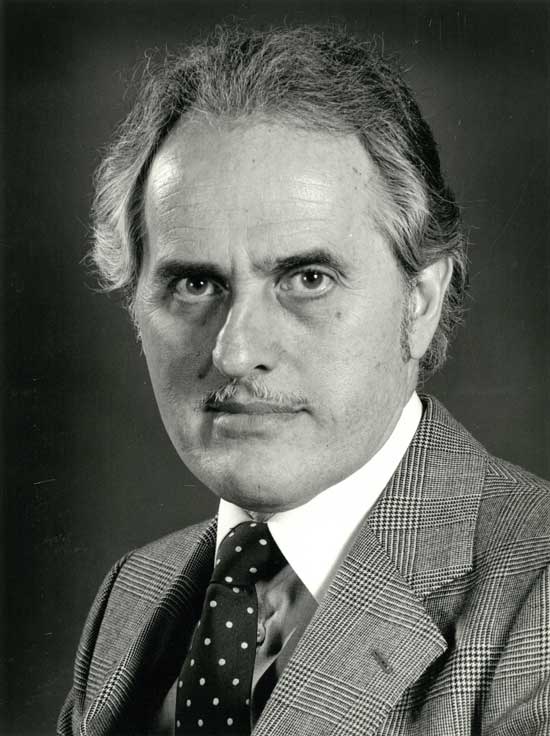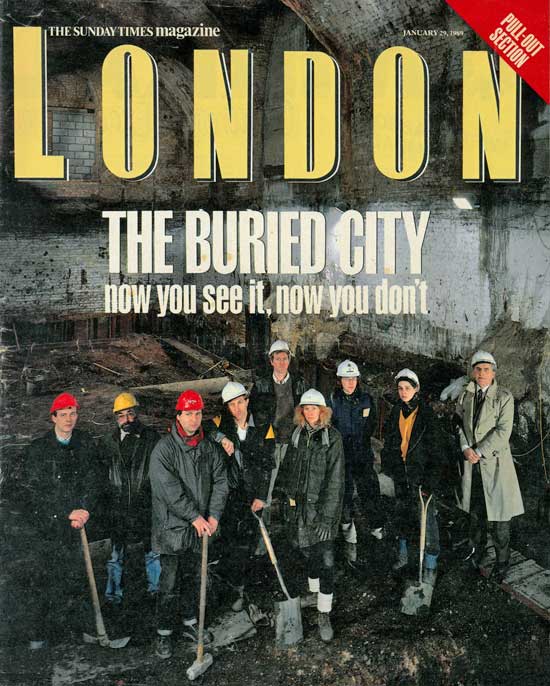Brian Hobley: head of the DUA (1973-89) remembered
Quintin Waddington
Brian Hobley, was Chief Urban Archaeologist of the Department of Urban Archaeology (DUA), Museum of London, from its inception in 1973 until his retirement in 1989, he passed away in 2023 aged 93). He was affectionally nick-named ‘the Great Man’ by his field-team. The DUA under Brian’s leadership made many significant archaeological discoveries, were responsible for fieldwork innovations and carried out some nationally important finds research, plus produced a wide range of publications.
 Brian Hobley (from the inside cover of Hobley 1986)
Brian Hobley (from the inside cover of Hobley 1986)
Brian was born in 1930 in South Shields and he had a twin, Michael and an older brother Peter. His father moved to Coventry in the 1930s, he was an aero engine fitter, presumably either at Armstrong Siddeley (the engine manufacturer) or their parent company Armstrong Whitworth (the aircraft manufacturer). Brian was a relative late comer to archaeology, having it is alleged previously been a used car salesman or his in own words ‘a self employed businessman’, actually he ran a radio and TV shop in Coventry, when he started working as an amateur archaeologist. He gained a BA honours degree in archaeology at the University of Leicester in 1965. In 1965 he became Keeper of the Department of Field Archaeology at Coventry Museum and in that role he gained valuable experience of urban archaeology. He also commenced the long-term excavation project of a Roman military site at Baginton including a 1st-century AD cavalry fort (the Lunt), which Brian was keen to have reconstructed.
By the late 1960s, the growing public concern about the unrecorded destruction of the City of London’s archaeological heritage during a number of high-profile redevelopments such as Baynard’s Castle in 1972 prompted the Corporation of London’s Guildhall Museum to form the DUA). Brian was appointed Chief Urban Archaeologist on 1 December 1973. The DUA’s field team quickly expanded from the five original members as various important waterfront excavations such as New Fresh Wharf and Trig Lane commenced. It quickly became apparent that the DUA would need the staff and resources to carry out a number of investigations simultaneously. During these early years of the DUA Brian was ably assisted by John Schofield (operations and publications), Tony Dyson (academic editor and historical researcher), Michael Rhodes (finds officer), Philip Armitage (environmental archaeologist), Peter Marsden (the Guildhall Museum’s former archaeology officer, who became responsible for writing up the pre-DUA fieldwork) and Trevor Hurst (photography), while secretarial support was provided by Diana Twells. During these early years new ideas of site recording were being considered to deal more efficiently with deeply stratified sites, in particular, the Harris Matrix: Brian and John Schofield - extended an invitation to Edwin Harris to address DUA staff and, thereafter, it led to the adoption of the matrix, single context planning and various types of proforma context sheets as part of DUA’s standard recording practice.
By 1988 the DUA had a team of 12 project managers involved in negotiations with developers and staff organisation, plus some 250 professional field archaeologists working in the City (on 58 sites in 1988), supported by a variety of specialist staff, with these skills including: computing; conservators; finds and environmental (technicians and specialists); graphics; photographic and surveying (Spence 1989). In 1988 the DUA negotiated a developer income of £3.89 million for a combination of fieldwork and post-excavation work in the City. In 1986 the adoption of electronic trading and financial deregulation in the City sparked a redevelopment boom, known as the ‘Big Bang’. This boom resulted in a massive increase in the fieldwork carried out by the DUA. Brian who was always keen to publicise the work of the DUA saw this as an opportunity. He was closely involved with a feature article in The Sunday Times magazine, published on 29 January 1989, entitled ‘Bang goes archaeology: rescuing the last of London’s past’. The magazine’s cover depicted Brian and a number of his supervisory staff from some of the excavations featured in the article. They were standing inside one of the arches of the massive Victorian viaduct, which forms the approach to Cannon Street station.
 Cover of The Sunday Times magazine. From left to right: Brian Pye (supervisor at the Roman basilica excavation at Whitington Avenue); Mike Shea (supervisor at the Roman baths excavation at Huggin Hill); Gary Brown (ditto Whittington Avenue); Gustav Milne (ditto medieval waterfronts at Thames Exchange); Angus Stephenson (ditto the Roman ‘governor’s palace’ and the Hanseatic Steelyard under Cannon Street Station approach); Chrissie Milne (Thames Exchange); Kieran Tyler (Thames Exchange); Jo Stephenson (Thames Exchange) and Brian Hobley
Cover of The Sunday Times magazine. From left to right: Brian Pye (supervisor at the Roman basilica excavation at Whitington Avenue); Mike Shea (supervisor at the Roman baths excavation at Huggin Hill); Gary Brown (ditto Whittington Avenue); Gustav Milne (ditto medieval waterfronts at Thames Exchange); Angus Stephenson (ditto the Roman ‘governor’s palace’ and the Hanseatic Steelyard under Cannon Street Station approach); Chrissie Milne (Thames Exchange); Kieran Tyler (Thames Exchange); Jo Stephenson (Thames Exchange) and Brian Hobley
One important innovation Brian was closely involved with adopting the policy the DAU seeking developer funding for excavations (starting in 1978, long before archaeological work was covered by planning conditions), post-excavation work and the sponsorship of publications (from 1980). Brian Hobley with his tweedy jackets and combed back hair clearly modelled himself on Sir Mortimer Wheeler, who thanks to Animal, Vegetable, Mineral (a 1952-9 TV show in which the panel of archaeologists, ecologists and historians and identified artefacts, fossils etc from museum collections) had become a celebrity. Like Sir Mortimer Brian tirelessly sought publicity and sponsorship for his endeavours, which included helping organise four international conferences on different aspects of urban archaeology all held at the Museum of London. Stories about Brian abound including how he used to treat site developers he was trying to get money off to lunch in the Corporation of London canteen, where they tucked into ‘brown stew’ and chips followed by spotted dick and custard! He was a familiar sight in the City of London on his Raleigh Shopper bike, wearing his long cream trench coat and a Gannex cap, this was long before urban cycling and wearing lycra became popular. There's the famous stage-managed moment, filmed for posterity by the BBC for a Chronicle documentary, recording when Brian came down to the Billingsgate lorry park excavation in late 1982 and gathered everyone round on site to inform them that the project had been given an extension. It is widely believed that the Chronicle crew, who were filming this moment, expected cheers of joy and safely helmets to be thrown in the air, but the team just looked at one another, shrugged their shoulders and went back to work. The nonplussed Chronicle director said to Brian 'they didn't seem impressed'. Quick as a flash Brian replied 'that’s because they're all professionals'. As Oscar Wilde remarked : There is only one thing in life worse than being talked about, and that is not being talked about.
Brian’s contribution to London’s archaeology is discussed at greater length in an article in LAMAS Trans 74 (due to published in November 2024).


Comments powered by CComment